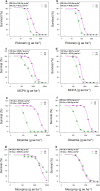Characterization of clopyralid resistance in lawn burweed (Soliva sessilis)
- PMID: 34191837
- PMCID: PMC8244908
- DOI: 10.1371/journal.pone.0253934
Characterization of clopyralid resistance in lawn burweed (Soliva sessilis)
Abstract
Soliva sessilis is a troublesome annual weed species in New Zealand turfgrass. This weed has been controlled selectively in New Zealand turfgrass for many years using pyridine herbicides such as clopyralid. However, in some golf courses, the continuous application of pyridine herbicides has resulted in the selection of S. sessilis populations that are resistant to these herbicides. This study focuses on a clopyralid-resistant population of S. sessilis collected from a golf course with a long history of clopyralid applications. The resistant phenotype of S. sessilis was highly resistant to clopyralid (over 225-fold). It was also cross-resistant to dicamba, MCPA and picloram but not mecoprop. The level of resistance to dicamba was high (7-14-fold) but much lower (2-3-fold) for both MCPA and picloram. The phenotype was morphologically distinct from its susceptible counterpart. Individuals of the clopyralid-resistant phenotype had fewer lobes on their leaves and were slightly larger compared to the susceptible phenotype. Resistant individuals also had a larger leaf area and greater root dry weight than the susceptible plants. An evaluation of internal transcribed spacer (ITS) regions confirmed that clopyralid-resistant phenotypes are conspecific with S. sessilis. In summary, the cross-resistance to several auxinic herbicides in this S. sessilis phenotype greatly reduces chemical options for controlling it; thus, other integrated management practices may be needed such as using turfgrass competition to reduce weed germination. However, the morphological differences between resistant and susceptible plants make it easy to see, which will help with its management.
Conflict of interest statement
The authors have declared that no competing interests exist.
Figures






Similar articles
-
Inheritance of resistance to clopyralid and picloram in yellow starthistle (Centaurea solstitialis L.) is controlled by a single nuclear recessive gene.J Hered. 2003 Nov-Dec;94(6):523-7. doi: 10.1093/jhered/esg101. J Hered. 2003. PMID: 14691320
-
Using accelerated life testing procedures to compare the relative sensitivity of rainbow trout and the federally listed threatened bull trout to three commonly used rangeland herbicides (picloram, 2,4-D, and clopyralid).Environ Toxicol Chem. 2008 Mar;27(3):623-30. doi: 10.1897/07-342.1. Environ Toxicol Chem. 2008. PMID: 17975948
-
A novel mutation in SoIAA20 confers cross-resistance to 2,4-Dichlorophenoxyacetic acid and other auxinic herbicides in Sonchus oleraceus.Pest Manag Sci. 2025 Jan;81(1):141-148. doi: 10.1002/ps.8413. Epub 2024 Sep 13. Pest Manag Sci. 2025. PMID: 39268911 Free PMC article.
-
Current state of herbicides in herbicide-resistant crops.Pest Manag Sci. 2014 Sep;70(9):1351-7. doi: 10.1002/ps.3727. Epub 2014 Feb 24. Pest Manag Sci. 2014. PMID: 24446395 Review.
-
Recent developments in metabolomics-based research in understanding transgenic grass metabolism.Metabolomics. 2019 Mar 15;15(4):47. doi: 10.1007/s11306-019-1507-4. Metabolomics. 2019. PMID: 30877485 Review.
Cited by
-
Inheritance of dicamba-resistance in allotetraploid Chenopodium album.Pest Manag Sci. 2022 Nov;78(11):4939-4946. doi: 10.1002/ps.7114. Epub 2022 Aug 17. Pest Manag Sci. 2022. PMID: 36181421 Free PMC article.
References
-
- Oerke EC. Crop losses to pests. J Agric Sci. 2005;144(1):31–43. Epub 12/09. doi: 10.1017/S0021859605005708 - DOI
-
- Harrington KC, Ghanizadeh H. Herbicide application using wiper applicators—A review. Crop Prot. 2017;102:56–62. 10.1016/j.cropro.2017.08.009. - DOI
-
- Heap I. The international survey of herbicide resistant weeds [online]. http://www.weedscience.com [Accessed 01.11.2020]. 2020.
-
- Ghanizadeh H, Harrington KC. Herbicide resistant weeds in New Zealand: state of knowledge. New Zeal J Agr Res. 2019:(in press). doi: 10.1080/00288233.2019.1705863 - DOI
Publication types
MeSH terms
Substances
LinkOut - more resources
Full Text Sources

